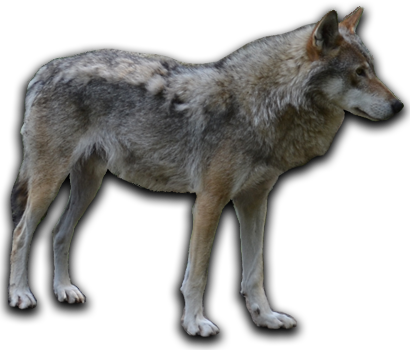Japanese T10 Carbon Steel Samurai Katana Sword Clay Tempered Blade Rayskin Saya
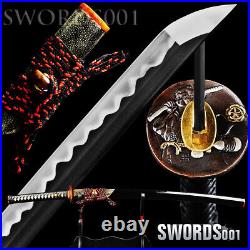
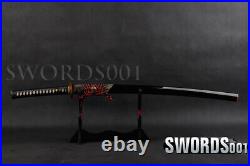
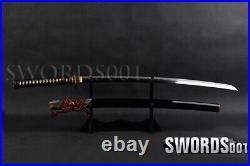
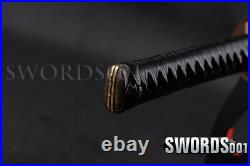
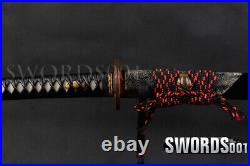
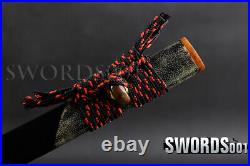
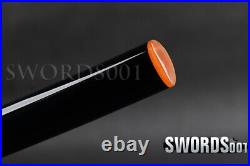
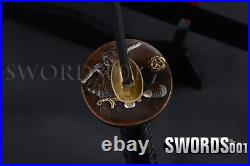
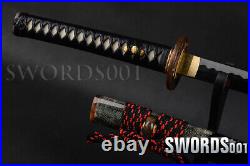
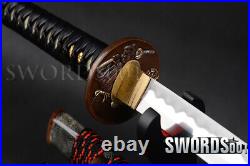
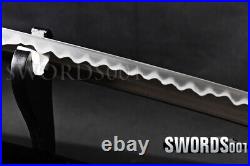
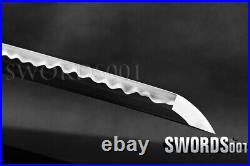

Japanese T10 Carbon Steel Samurai Katana Sword Clay Tempered Blade Rayskin Saya. Samurai katana as a weapon is famous for its beautiful shape. They are used as art collection and the symbol of samurai soul. Our sword allows you to make a collection or to send to friends as a present. This katana can be taken apart fully at anytime for maintenance purposes, you can disassemble the sword by taking out the pegs from the handle. OVERALL LENGTH: 103 cm / 40.6 inch. BLADE LENGTH: 70 cm / 27.6 inch. TSUKA LENGTH: 26 cm / 10.24 inch. BLADE WIDTH: 3.2 cm / 1.26 inch. BLADE THICKNESS: 0.7 cm / 0.28 inch. BLADE CRAFT: fully hand forged, hand polished (Shitaji togi + Shiage togi), clay hardened, water quenching. BLADE MATERIAL: T10 carbon steel. KISSAKI: medium tip (chukissaki). HAMON: real hamon, clay hardened line. POLISHING STYLE: Shiage togi + Hadori. TSUKA(HANDLE): hard wood core, hineri maki. MEKUGI: 2 bamboo pegs. TSUKA-ITO: black genuine leather cord. SAMEGAWA: genuine white rayskin. FUCHI / KASHIRA: gold plated brass, bamboo. MENUKI: gold plated brass, flowers. TSUBA(HAND GUARD): gold silver plated brass, samurai. SEPPA: high quality brass. HABAKi: high quality brass. SAGEO: black & red synthetic silk specialized cord. SAYA: glossy black lacquered wooden scabbard with amber buffalo horn Kurigata Koiguchi Koijiri. 1 sword with saya. 1 1-layer black wooden stand. The best quality of high carbon steel is T10, the carbon content was 1.03%, and the element contains a small amount of chromium, molybdenum, vanadium, after heat treatment can reach HRc 58-60 hardness. Toughness is very good, but it is not resistant to rust. It is applied to traditional european-style hunting knife, large cutting knife and military dao. Before being quenched, a special clay mixture can be applied onto the blade to harden the edge and obtain different hardness on the blade. The clay mixture was a special recipe and considered a crucial trade secret, guarded protectively by sword making masters. It would contain such things as feathers, powdered bones, grass, etc. And would be applied to the edge of the blade before being quenched. During quenching, a chemical reaction between the clay mixture and the hot steel occurs during the sudden temperature drop and carbon is fed into the blade in high amounts, creating an extremely tough edge. A clay hardened blade can only be quenched in water, thus increasing the defect rate even more. Another way for clay tempering is to apply clay along the blade but let edge exposed. Thus, while quenching the blade into water, the uncovered edge will cool down suddenly, but the rest of blade will cool down slowly. Such differential temperature change results in the different hardness of the blade. So the edge is tough enough to cut, where the back of blade is soft /flexible enough to absorb the impact during cutting. Such quenching process usually will leave beautiful wavy tempered line on the blade, as known as “hamon” in Japanese swords term. The polishing process is divided into two stages:Shitaji togi and Shiage togi. Shitaji togi is Foundation polishing, to correct any bends in the blade. Shiage togi is the stage that places the mirrorlike finish on a blade. This sword used Shiage togi, it is a elaborate process to the blade, it uses small grindstone to polish the blade by hand to make the blade mirrorlike, it is a time-consuming work, it can effectively increase the sword’s monetary, historic, artistic, and functional value. The Modern Style Polishing (Hadori Style Polishing). It is designed to highlight the aesthetics of the blade. In this style polishing, the hamon appears white against the black, shining steel and the mirror finished shinogi-ji. It is so aesthetic that it makes a blade perfect for display. The white pattern that looks like hamon is called “HADORI”. It is not a true hamon, but it is designed by polisher along the hamon to exaggerate it. When you look at the blade under a proper light, you can see the true hamon under the hadori. With the modern polishing style, you can see the blades with aesthetically “made-up face”. This polishing style was developed by a famous polisher in the early 20th century. If you don’t like the original mountings, you can choose the favorite ones from the options. Handle wrapping cord and saya cord should be the same color. If you only want to change one of them to another color, please inform of it specially. We can engrave English words, Chinese Characters on the blade for free. We can add or remove the machine-made wavy hamon for free. Usually thought be used for bloodletting only. It is also used to lighten the weight of the sword. We can add or remove Bo-hi for free. Most of our blades are sharp. We can also make the blade unsharpened for free if you require. The price varies from different swords. International Buyers – Please Note. Please contact with us before you leave feedback. We will try our best to solve the problem for you, thank you. Sometimes, you may not get our reply immediately due to the time difference among each country. However, please be assured that we’ll strive to reply you as soon as possible once we got your messages. This item is in the category “Collectibles\Knives, Swords & Blades\Swords & Sabers\Asian\Japanese”. The seller is “swords001″ and is located in this country: CN. This item can be shipped worldwide.
- Type: katana
- Tang: Full
- Handle Material: Wood
- Blade Material: Carbon Steel
- Theme: Samurai
- Dexterity: Right-Handed
- Edge: Single, Curved
- Handedness: Double-Handed
- Brand: SJ SHI JIAN
- Color: Black
- Country/Region of Manufacture: China
- Original/Reproduction: Original
- Style: Japanese

